Some of my most popular presentations are about weird and ugly creatures! I love the reactions I get when I show photos of some of the ugliest creatures found on our planet – especially those that live in the deep sea!
Deep sea creatures have some unique adaptations for living in the icy cold, pitch black depths of the oceans far below the photic zone where light penetrates. They can have fishing lures that glow in the dark, immense teeth to hold onto prey, and giant stomachs. We may consider these adaptations weird and ugly, but they can be key to survival in the oceans depths of the world.
There’s a certain beauty to adaptations that allow these creatures to survive and thrive in the extreme conditions of the deep sea.
How Do Fish Find Food in the Immense Ocean Spaces?
One of the biggest challenges for deep sea creatures is the immensity of the oceans in all directions. We humans are “flat earth” creatures used to operating primarily in one plane on the surface of the planet. In contrast, the vast oceans are three dimensional – several miles deep and hundreds or thousands of miles wide from shore to shore. Satellite measurements show that the oceans hold 0.3 billion cubic miles (1.332 billion cubic kilometers) of water with an average ocean depth of 2.3 miles (3,682.2 meters).
That is an almost unimaginable volume of water when considered on a human scale. In fact, less than 1% of the biosphere on our planet is terrestrial. This 1% includes the surfaces of all of the continents and the land creatures we are most familiar with. 99% of the biosphere is found in the waters of the world.
These immense spaces can make it especially difficult for deep-sea fish to find food. When they do come across something to eat, they want to make darn certain that any creature worth eating will not escape!
Solution? BIG mouths with needle-sharp teeth to grab and hold anything that moves!!
Sloane’s Viperfish (Chauliodus sloani) is a great example of a fish with a big mouth filled with needle-sharp teeth that can grab and hold even the wriggliest of prey animals. When the jaw is closed, the teeth fit together to form a cage that can trap prey. It can unhinge its jaws, allowing it to open its mouth up to 90° to catch prey up to 63% its own body size.
Fortunately, these fish are not large and people rarely meet them in real life! They grow up to 11-12 inches or 30 cm and live in the deep ocean.

This anglerfish is another good example of a big mouth and needle sharp teeth.
Doesn’t this Humpback anglerfish look like the quintessential ugly sea creature?!
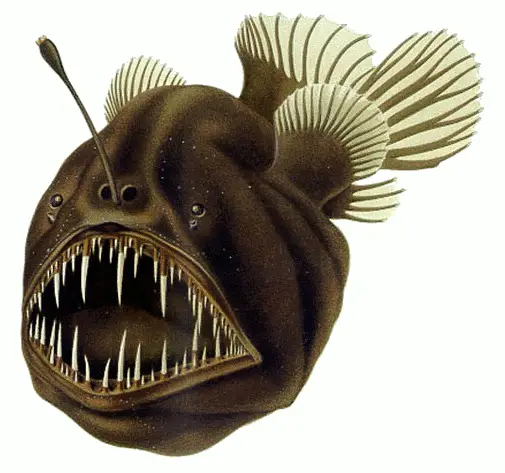

How do Anglerfish Attract Prey?
The anglerfish’s “fishing pole and lure” is a very clever adaptation given the problem of potential prey being few and far between. The lure at the end of the fishing pole is bioluminescent and, in some species, the fish can even wriggle it like a worm! Imagine another fish swimming by when it sees this lure bobbing about in the pitch black of the vast ocean. It will need to investigate, of course, hoping that it has managed to find something edible in the vast biological desert of the deep sea.
As soon as a fish comes close to investigate the lure…BAM! Game over! The angler fish gulps and grabs and the curious fish becomes dinner.
The anglerfish might be considered ugly by human standards, but as you can see, these are beautiful adaptations to attracting and eating any creature that might swim by.
MBARI video of anglerfish – first of its species captured on video
The video above shows a female – to find out more about the amazing role of male anglerfish check out my related article about how Anglerfish mate and why males become sexual parasites!
How Does Camouflage Work in the Deep Sea?
One of the most intriguing adaptations is the use of bioluminescence as camouflage. At the bottom end of the photic zone around 200 to 1,000 m deep there’s enough light penetrating down through the ocean waters to make a fish stand out in silhouette when viewed from below.
There are plenty of predatory fish patrolling those depths, watching for any creature making a shadow against the very faint light penetrating from above.
Solution: rows of bioluminescent light-producing organs along their bellies. These organs shine a pale blue light that matches the color of daylight from above, hiding them from predators below.
Hatchetfish are among the many deep-sea creatures that use bioluminescence for camouflage. Special light-producing organs known as photophores point downward, hiding the fish from predators through counterillumination. Hatchetfish can adjust the intensity of the lights to make them nearly invisible against the faint light coming from above.
Known as ‘bioluminescent counter-illumination’, this adaptation is one of the most effective forms of camouflage found in marine organisms throughout the oceans.
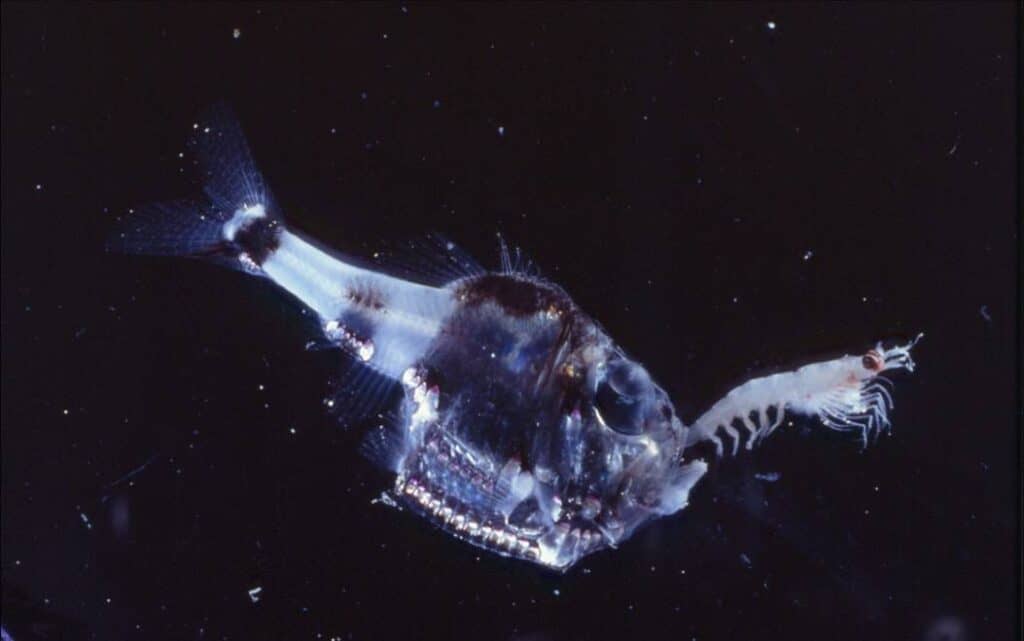
Hatchetfish are very thin in the thorax. Their body shape reminds people of a hatchet with the tail as the handle and the thin thorax as the blade.

There’s something special about the expressions on these Hatchetfish that makes them look almost human! OK, very, very scary looking humans! Perhaps these ones are still recovering from a close encounter with a Viperfish!
Hatchetfishes have large, bulging eyes that are well-adapted to the extremely faint illumination from above and they can readily distinguish the silhouettes of any edible creatures they may come across.
Can you look straight up through the top of your head?
Sounds silly, doesn’t it? Well, don’t jump to any conclusions, because this would be a handy way of keeping track of food items drifting down from above. (No, I don’t mean your food of course, but if you lived in the deep sea it would definitely be useful!)
Let me introduce you to the Barreleye.
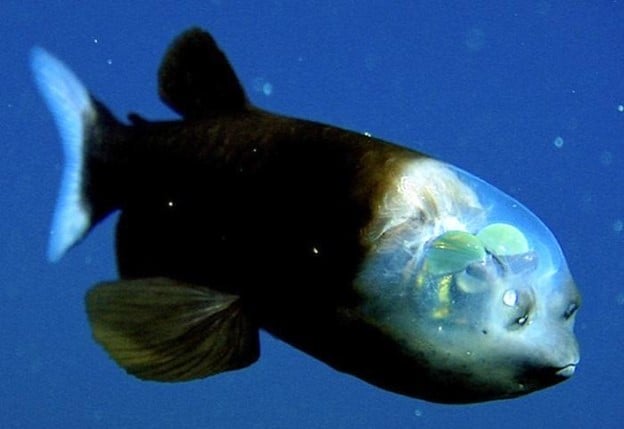
Look carefully at the photo above and guess where the eyes are located. They should be above the small mouth, right? Sorry, those are the nostrils. The green semi-spherical shapes are its eyes.
The Barreleye has a transparent dome with tubular eyes inside its head. Initially, people believed that its large green eyes were fixed in position and could only look straight upwards. However, scientists with the Monterey Bay Aquarium Research Institute (MBARI) have discovered that the Barrelleye can rotate its eyes forward, which would be particularly handy when chasing its prey.
Barreleyes live nearly in total darkness. Like the hatchetfish, their eyes are adapted to watching for the faintest shadow of a potential food source floating above.
If you had food falling down from above you might wish you had a transparent head!
Barreleye video by MBARI
Biting off more than you can chew
Here’s another useful adaptation for living in the deep sea: grab and swallow anything you possibly can… even if it is bigger than you!
Meet the Black Swallower Fish. This fish is well named: it can eat other fish that are more than four times its size.

We’ve seen how food in the deep sea can be very scarce and hard to find, so another useful adaptation is to have a huge stomach and jaws that open very wide. The Black Swallower uses this strategy to swallow prey whole and to trap them alive in its stomach. This can be a dicey proposition, however, if the prey species puts up a big fight and manages to break free. Talk about a stomach-ache!
Another problem could arise if the prey fish is too large. The Black Swallower might not be able to digest the body fast enough before it begins to decompose, releasing gases that would make the swallower float to the surface where it would die. Death by indigestion!
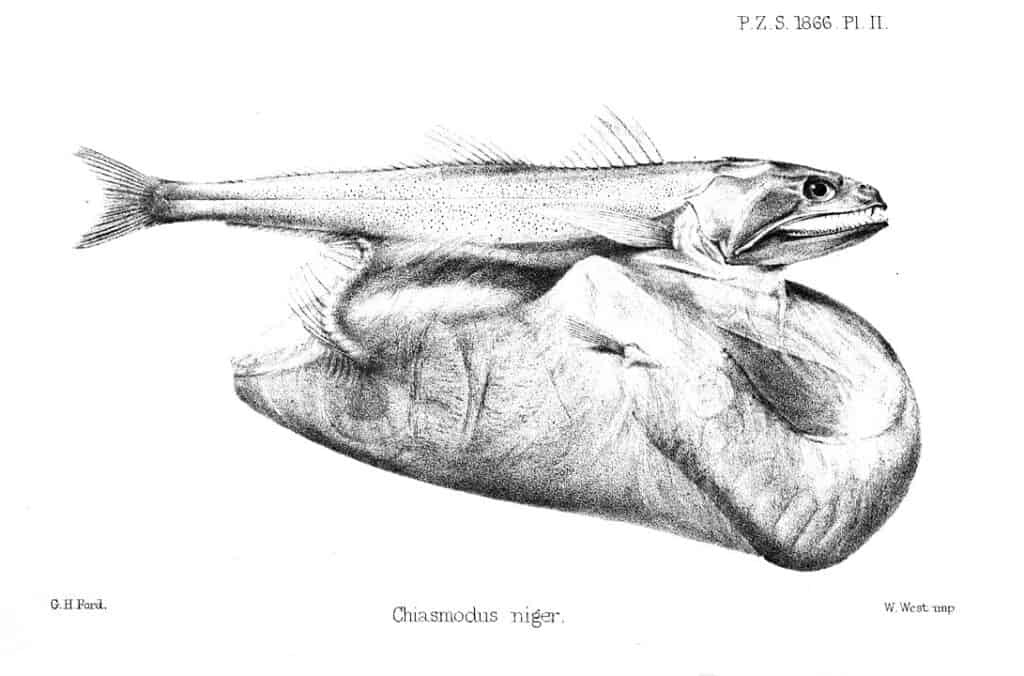
Here’s a short video clip of a Black swallower in its native habitat taken by NOAA.
Here’s a close look at another fish that can swallow prey larger than itself. This is the hairy anglerfish:
If Ugliness is in the Eye of the Beholder, Behold the Blobfish!
I hope I’ve convinced you that there’s a certain elegance and beauty in these amazing adaptations by creatures that survive and thrive in the deep oceans of the world.
The Blobfish was once voted the ugliest fish in the world!
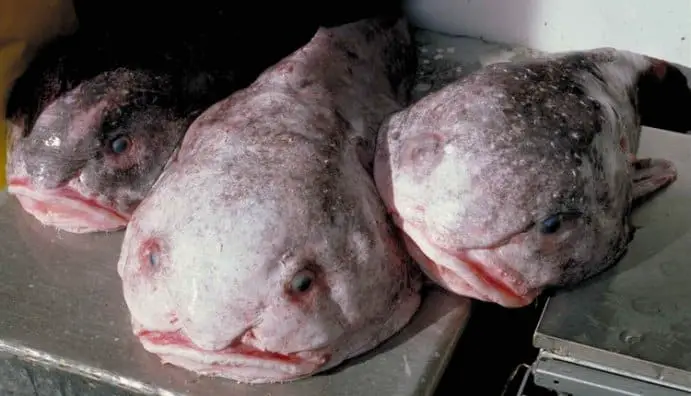
They might look ugly out of the water, but in their native habitat at the ocean bottom they just fit right in, takin’ it easy, waitin’ for something edible to arrive.
For an added bonus check out my short 1 minute video of ugly fish celebrating Christmas!

Check Out Our TOP Articles for Even More Fascinating Creatures
- How do Octopus Reproduce? (Cannibalistic Sex, Detachable Penis)
- Do Jellyfish have Brains? How Can they Hunt without Brains?
- Why are Deep Sea Fish So Weird and Ugly? Warning: Scary Pictures!
- Are Komodo Dragons Dangerous? Where Can you See Them?
- Koala Brains – Why Being Dumb Can Be Smart (Natural Selection)
- Why do Lions Have Manes? (Do Dark Manes Mean More Sex?)
- How Do Lions Communicate? (Why Do Lions Roar?)
- How Dangerous are Stonefish? Can You Die if You Step on One?
- What Do Animals Do When They Hibernate? How do they Survive?
- Leaf Cutter Ants – Surprising Facts and Adaptations; Pictures and Videos
- Irukandji Jellyfish Facts and Adaptations; Can They Kill You? Are they spreading?
- How to See MORE Wildlife in the Amazon: 10 Practical Tips
- Is it Safe to go on Safari with Africa’s Top Predators and Most Dangerous Animals?
- What to Do if You Encounter a Bullet Ant? World’s Most Painful Stinging Insect!
- How Do Anglerfish Mate? Endless Sex or Die Trying!
- How Smart are Crocodiles? Can They Cooperate, Communicate…Use Tools?
- How Can We Save Our Oceans? With Marine Sanctuaries!
- Why Are Male Birds More Colorful? Ins and Outs of Sexual Selection Made Easy!
- Why is the Cassowary the Most Dangerous Bird in the World? 10 Facts
- How Do African Elephants Create Their Own Habitat?
- What is Killing Our Resident Orcas? Endangered Killer Whales
- Why are Animals of the Galapagos Islands Unique?
- Where Can You See Wild Lemurs in Madagascar? One of the Best Places
- Where Can You see Lyrebirds in the Wild? the Blue Mountains, Australia
- Keeping Mason Bees as Pets
- Why do Flamingos have Bent Beaks and Feed Upside Down?
- Why are Hippos Dangerous? Why Do They Kill People?
